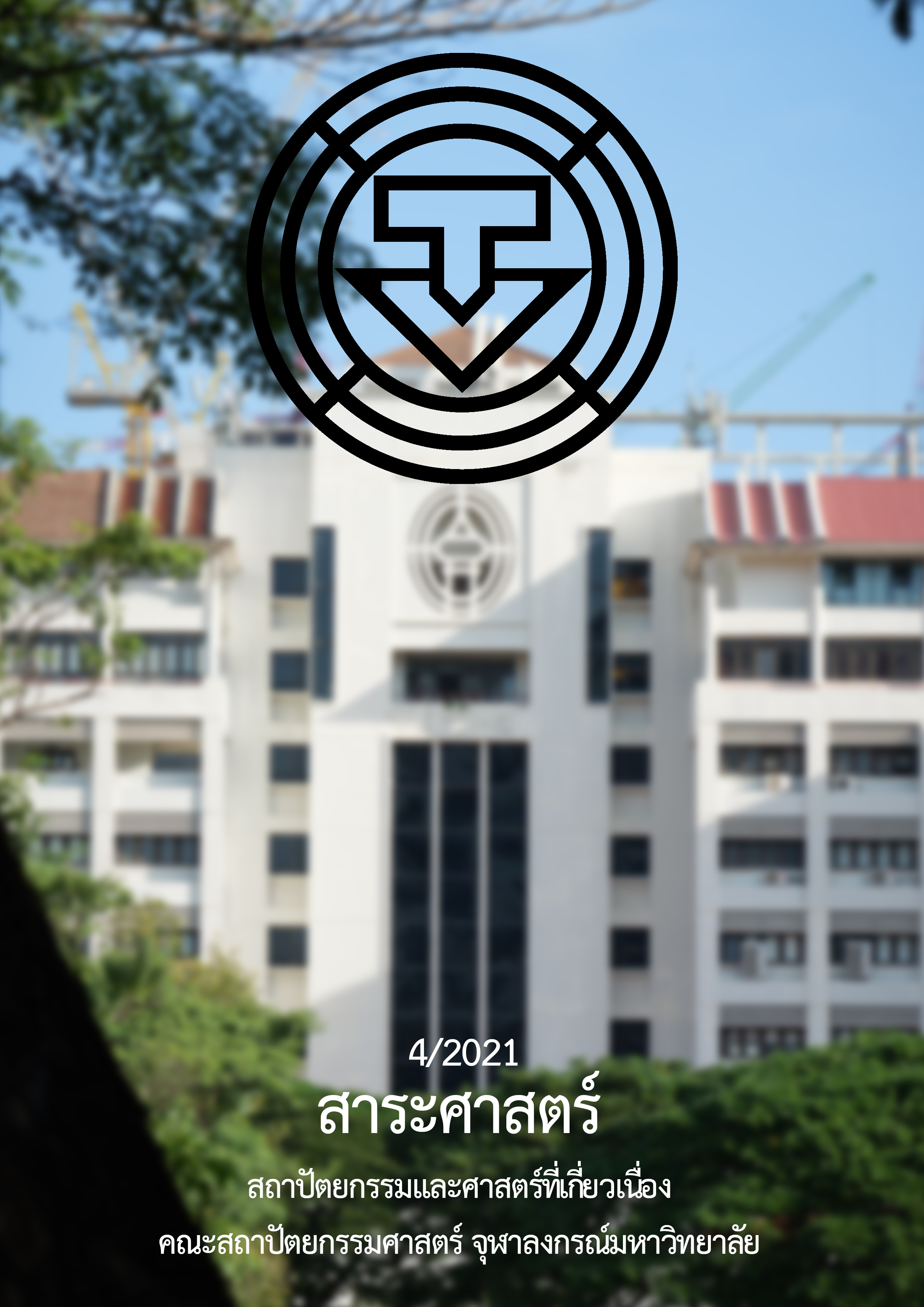การอนุรักษ์และฟื้นฟูเรือนแถวพื้นถิ่นในย่านเมืองเก่าสกลนคร
Main Article Content
บทคัดย่อ
การอนุรักษ์และฟื้นฟูเป็นหนึ่งในวิธีการที่ช่วยรักษาเรือนแถวพื้นถิ่นในย่านเมืองเก่าสกลนคร การวิจัยนี้มีวัตถุประสงค์เพื่อศึกษาสภาพปัจจุบัน ตลอดจนการเปลี่ยนแปลงลักษณะทางกายภาพและการใช้งานของเรือนแถว นอกจากนี้การวิจัยนี้ยังสำรวจสาเหตุ วัตถุประสงค์และแนวคิดที่นำไปสู่เทคนิควิธีการอนุรักษ์และฟื้นฟูเรือนให้สอดคล้องกับการใช้งานในปัจจุบัน แล้วนำผลการศึกษามาสรุปและเสนอแนวทางการอนุรักษ์และฟื้นฟูที่เหมาะสมกับเรือนแถวพื้นถิ่น วิธีวิจัยเริ่มต้นจากการสำรวจพื้นที่ศึกษาเบื้องต้น ร่วมกับการศึกษาเอกสารและงานวิจัยที่เกี่ยวข้อง จากนั้นคัดเลือกกรณีศึกษาเพื่อศึกษาเชิงลึกด้วยการสำรวจ การรังวัด และการสัมภาษณ์
ผลการศึกษาพบว่า ในปัจจุบัน เรือนแถวพื้นถิ่นในพื้นที่ศึกษาส่วนใหญ่ยังมีการใช้งาน ขณะเดียวกันเรือนบางส่วนกลับถูกทิ้งร้าง จากกรณีศึกษาแสดงให้เห็นว่า เรือนแถวถูกเปลี่ยนแปลงทางกายภาพจากการอนุรักษ์และฟื้นฟู ซึ่งอาจลดทอนความแท้และบูรณภาพของเรือน ในทางกลับกัน การดำเนินงานได้ช่วยส่งเสริมการใช้ประโยชน์ ส่งเสริมภูมิทัศน์ย่านเมืองเก่า รักษาองค์ความรู้ทางสถาปัตยกรรม และหลักฐานทางประวัติศาสตร์ของพื้นที่ นอกจากนั้นยังช่วยรักษาคุณค่าทางจิตวิญญาณของอาคาร
ข้อเสนอแนะแนวทางในการอนุรักษ์ฟื้นฟูเรือนประกอบด้วย การส่งเสริมภูมิทัศน์ย่านเมืองเก่าที่มุ่งเน้นการอนุรักษ์ผนังและองค์ประกอบภายนอก การส่งเสริมการใช้ประโยชน์อย่างร่วมสมัยที่ช่วยเพิ่มคุณค่าด้านการใช้งานและเศรษฐกิจ การเพิ่มความสำคัญของการจัดทำเอกสารรวบรวมข้อมูลและบันทึกสภาพของเรือน การประเมินคุณค่าก่อนการดำเนินงาน การอนุรักษ์ไม้และใช้วัสดุในท้องถิ่น ตลอดจนการวางแผนการบำรุงรักษาอาคารตามขั้นตอนการอนุรักษ์และฟื้นฟู
Article Details
เอกสารอ้างอิง
การเคหะแห่งชาติ. (2549). โครงการศึกษาแนวทางการพัฒนาและฟื้นฟูที่อยู่อาศัยที่ส่งเสริมเอกลักษณ์ของเมืองจังหวัดสกลนคร.(ม.ป.ท.).
เกิด อุ่มภูธร. (2561, 1 เมษายน). สัมภาษณ์.
ชำนาญ บุญญาพุทธิพงศ์. (2553). ความเปลี่ยนแปลงของเฮือนอีสาน. ใน สวนันต์ ธรรมแก้ว (บรรณาธิการ), ภูมิปัญญาชาวบ้าน สู่งานสถาปัตยกรรมพื้นถิ่น (น.91-100). กรุงเทพฯ: บริษัท พลัสเพรส จำกัด.
ธาดา สุทธิธรรม. (2554). หลักการอนุรักษ์มรดกสถาปัตยกรรมและการอนุรักษ์มรดกสถาปัตยกรรมพื้นถิ่นอีสานในแนวทางการมีส่วนร่วม. ขอนแก่น: มูลนิธิภูมิปัญญา สิ่งแวดล้อม วัฒนธรรมและศิลปะเอเซีย.
พีระเดช จักรพันธุ์, ม.ร.ว. และ คณาจารย์. (2553). สถาปัตยกรรมพื้นถิ่น. ใน สวนันต์ ธรรมแก้ว (บรรณาธิการ), ภูมิปัญญาชาวบ้าน สู่งานสถาปัตยกรรมพื้นถิ่น (น.9-26). กรุงเทพฯ: บริษัท พลัสเพรส จำกัด.
ยงธนิศร์ พิมลเสถียร. (2556a). การปรับปรุงฟื้นฟูเมืองและการอนุรักษ์เมือง. ปทุมธานี: โรงพิมพ์แห่งมหาวิทยาลัยธรรมศาสตร์.
ยงธนิศร์ พิมลเสถียร. (2556b). ย่านเมืองเก่าและชุมชนดั้งเดิมกับการอนุรักษ์. เมืองโบราณ, 39(2), 94-107.
รวินทร์ ถิ่นนคร. (2550). โอกาสในการอนุรักษ์ ฟื้นฟูที่อยู่อาศัยย่านเมืองเก่าสกลนคร. (วิทยานิพนธ์ปริญญามหาบัณฑิต, จุฬาลงกรณ์มหาวิทยาลัย).
วรวิทย์ จันทเดช. (2559, 19-20 ธันวาคม). ปัจจัยการดำรงอยู่ของกลุ่มเรือนไม้ดั้งเดิมในย่านเมืองเก่าสกลนคร. บทความจากการประชุมวิชาการระดับชาติ “สถาปัตย์กระบวนทัศน์” และการประชุมระดับนานาชาติ “สถาปัตย์ปาฐะ” พ.ศ. 2559. กรุงเทพฯ: ศูนย์มานุษยวิทยาสิรินธร.
วิวัฒน์ เตมีย์พันธ์. (2553). แนวทางการศึกษาสถาปัตยกรรมพื้นถิ่น. ใน สวนันต์ ธรรมแก้ว (บรรณาธิการ), ภูมิปัญญาชาวบ้าน สู่งานสถาปัตยกรรมพื้นถิ่น (น.27-46). กรุงเทพฯ: บริษัท พลัสเพรส จำกัด.
สพสันติ์ เพชรคำ. (2560). ประวัติศาสตร์ท้องถิ่นสกลนคร. สกลนคร: สถาบันภาษา ศิลปะและวัฒนธรรม มหาวิทยาลัยราชภัฏสกลนคร.
สมชาติ จึงสิริอารักษ์. (2540). การอนุรักษ์โครงสร้างและวัสดุของโบราณสถาน [เอกสารไม่ได้ตีพิมพ์]. กรุงเทพฯ: คณะสถาปัตยกรรมศาสตร์ มหาวิทยาลัยศิลปากร.
สำนักงานนโยบายและแผนทรัพยากรธรรมชาติและสิ่งแวดล้อม. (2558). โครงการกำหนดขอบเขตพื้นที่เมืองเก่า: เมืองเก่าสกลนคร. กรุงเทพฯ: กระทรวงทรัพยากรธรรมชาติและสิ่งแวดล้อม.
สุวิทย์ ธีรศาศวัต. (2557). ประวัติศาสตร์อีสาน 2322-2488 เล่ม 2. ขอนแก่น: คณะมนุษยศาสตร์และสังคมศาสตร์มหาวิทยาลัยขอนแก่น.
อรศิริ ปาณินท์ และ สมคิด จิระทัศนกุล. (2544). เรือนค้าขายพื้นถิ่นในชุมชนเมือง. กรุงเทพฯ: เจ พริ้น.
Australia ICOMOS. (2013). The Burra Charter: The Australia ICOMOS charter for places of cultural significance. Retrieved from https://australia.icomos.org/wp-content/uploads/The-Burra-Charter-2013-Adopted- 31.10.2013.pdf
Douglas, J. (2002). Building adaptation. Oxford: Butterworth-Heineman.
Feilden, B. M. (1995). Conservation of historic buildings. Oxford: Butterworth-Heinemann.
Grimmer, A. E. (2017). The secretary of the interior’s standards. Washington, DC: National Park Service, U.S. Department of the Interior.
ICOMOS. (1999). Charter on the built vernacular heritage. (1999). Retrieved from https://www.icomos.org/images/DOCUMENTS/Charters/vernacular_e.pdf
ICOMOS. (2017). Principles for the conservation of wooden built heritage. Retrieved from https://www.icomos.org/images/DOCUMENTS/Charters/GA2017_6-3-4_WoodPrinciples_EN_adopted-15122017.pdf
Jokilehto, J. (2002). A history of architectural conservation. Oxford: Butterworth-Heinemann.


